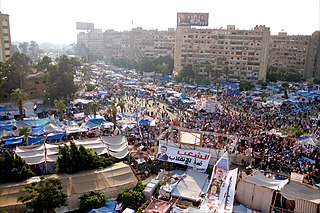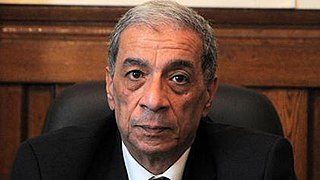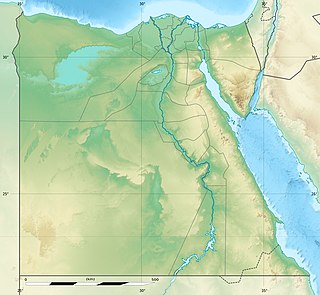
Mohammed Badie is the eighth Supreme Guide of the Muslim Brotherhood.

The Egyptian Crisis began with the Egyptian revolution of 2011, when hundreds of thousands of Egyptians took to the streets in an ideologically and socially diverse mass protest movement that ultimately forced longtime president Hosni Mubarak from office. A protracted political crisis ensued, with the Supreme Council of the Armed Forces taking control of the country until a series of popular elections, which are thought to have been tampered with, brought the Muslim Brotherhood to power. However, disputes between elected Islamist president Mohamed Morsi and secularists continued until the anti-government protests in June 2013 that led to the overthrow of Morsi in 2013, in what has been variably described as a coup d'état or as an ending to the second revolution, or both. Abdel Fattah el-Sisi, who announced the overthrow of Morsi, then became the leader of Egypt the following year, winning election to the presidency in a landslide victory described by EU observers as free but not necessarily fair. Nonetheless, Sisi's election was widely recognized, and the political situation has largely stabilized since he officially took power; however, some protests have continued despite a government crackdown. The crisis has also worsened an ongoing insurgency led by Ansar Bait al-Maqdis in the Sinai Peninsula, which became increasingly intertwined with the regional conflict against the Islamic State of Iraq and the Levant later in 2014.

The following is a chronological summary of the major events that occurred during the Egyptian Revolution of 2011, after Hosni Mubarak's resignation. Protests and riots led to the deaths of hundreds, injuries of thousands and the arrests of tens of thousands. Millions have mobilised the streets since the revolution.

The al‑Nour Party, or "Party of The Light", is one of the political parties created in Egypt after the 2011 Egyptian Revolution. It has an ultra-conservative Islamist ideology, which believes in implementing strict Sharia law. It has been described as the political arm of the Salafi Call Society, and "by far the most prominent" of the several new Salafi parties in Egypt, which it has surpassed by virtue of its "long organizational and administrative experience" and "charismatic leaders". Its political aim is to establish a theocratic state on the lines of Wahhabism like in Saudi Arabia. Saudi Arabia was found to be the main financer of the party according to the public German television news service ARD (broadcaster).

Mohamed Mohamed Morsi Issa Al-Ayyat was an Egyptian politician and engineer who served as the fifth President of Egypt, from 30 June 2012 to 3 July 2013, when General Abdel Fattah el-Sisi removed him from office in a coup d'état after protests in June. An Islamist affiliated with the Muslim Brotherhood organisation, Morsi led the Freedom and Justice Party from 2011 to 2012.
The Maspero Massacre initially started as demonstrations on October 2011 by a group dominated by Egyptian Copts in reaction to the demolition of a church in Upper Egypt claimed to be built without the appropriate license. The peaceful protesters who intended to stage a sit-in in front of the Maspiro television building were attacked by security forces and the army, resulting in 24 deaths, mostly among the Coptic protestors, and 212 injuries, most of which were sustained by Copts.
On 1 February 2012, a massive riot occurred at Port Said Stadium in Port Said, Egypt, following an Egyptian Premier League football match between Masry and Ahly. 74 people were killed and more than 500 were injured after thousands of Masry spectators stormed the stadium stands and the pitch, following a 3–1 victory by their team, and violently attacked Ahly fans using clubs, stones, bottles, and fireworks, trapping them inside the El Ahly partition of the stadium. Many of the deaths were due to the police's refusal to open the stadium gates, trapping the Ahly fans inside, leaving some to die, and killing others in a stampede to escape. Civil unrest and severe clashes continued until 11 February but general strikes ended on 13 February. Riots erupted in Cairo, Alexandria, Suez and Luzon. Police fired tear gas at protesters thus clashes erupted on the streets due to battles of tear gas. Unrest calmed and ended on 13 February.

Hesham Mohamed Qandil is an Egyptian engineer and civil servant who was Prime Minister of Egypt from 2012 to 2013. Qandil was appointed as Prime Minister by President Mohamed Morsi on 24 July 2012 and sworn in on 2 August 2012. Qandil previously served as Minister of Water Resources and Irrigation from 2011 to 2012.

The 2012–2013 Egyptian protests were part of the crisis in Egypt including the June 2013 protests, the July 2013 coup d'état, and part of the post-coup unrest. They saw varying opposition against three contiguous heads of state; namely, SCAF, Muslim Brotherhood, and the de facto ruling Egyptian Armed Forces.
The Anti-Coup Alliance is a coalition in Egypt formed to reverse the ouster of former president Mohamed Morsi. The coalition is made up of approximately 40 Islamist parties and groups.

The 2013 Egyptian coup d'état took place on 3 July 2013. Egyptian army chief General Abdel Fattah al-Sisi led a coalition to remove the President of Egypt, Mohamed Morsi, from power and suspended the Egyptian constitution of 2012. The move came after the military's ultimatum for the government to "resolve its differences" with protesters during widespread national protests. The military arrested Morsi and Muslim Brotherhood leaders, and declared Chief Justice of the Supreme Constitutional Court Adly Mansour as the interim president of Egypt. The announcement was followed by demonstrations and clashes between supporters and opponents of the move throughout Egypt.

The 30June protests occurred in Egypt on 30 June 2013, marking the one-year anniversary of Mohamed Morsi's inauguration as president. The events ended with the 2013 Egyptian coup d'état after mass protests across Egypt demanding the immediate resignation of the president. The rallies were partly a response to Tamarod, an ostensibly grassroots movement that launched a petition in April earlier that year calling for the government to step down claiming to have collected 22 million signatures, a figure not verified by independent sources with skepticism over the rise in number by millions in a matter of days, with the Freedom and Justice Party putting the figure at 170,000 signatures. A counter campaign was launched in support of Morsi's presidency which claimed to have collected 11 million signatures. According to the Egyptian military, which calculated figured via helicopter scans of demonstration perimeters across the country, this was "the biggest protest in Egypt's history", with 32 million protesters. However, independent observers have raised concerns about wild exaggeration of the number of actual anti-Morsi protestors with one crowd statistical expert study indicating that a total of a little more than 1 million people protested against Morsi across the whole country.

Protests against the 2013 Egyptian coup d'état erupted in July 2013. Immediately following the removal of President Mohamed Morsi by the Egyptian Armed Forces on 3 July 2013 amid demonstrations against Morsi's rule, many protesters amassed near the Rabia Al-Adawiya Mosque to call for Morsi's return to power and condemn the military, while others demonstrated in support of the military and interim government. Deadly clashes such as Rabaa massacre continued for several days, with three particularly bloody incidents being described by Muslim Brotherhood officials as "massacres" perpetrated by security forces. During the month of Ramadan, prime minister Hazem al-Beblawy threatened to disperse the ongoing Pro-Morsi sit-ins in Rabaa al-Adaweya square and al-Nahda square. The government crackdown of these protests occurred in a violent dispersal on 14 August 2013. In mid-August, the violence directed by the army towards the protesters escalated, with hundreds killed, and the government declaring a month-long nighttime curfew.

Hisham Muhammad Zaki Barakat was Prosecutor General of Egypt from 2013 to 2015. During his term as state prosecutor, he was responsible for thousands of controversial prosecutions, including several widely deemed politically motivated resulting in death sentences for hundreds of Muslim Brotherhood members and supporters of deposed Egyptian President Mohamed Morsi. He was assassinated in a car bombing on 29 June 2015.
Mohamed Ibrahim Moustafa, often referred to simply as Mohamed Ibrahim was the Minister of Interior of Egypt, from January 2013 until March 2015.

On 14 August 2013, Egyptian security forces and army under the command of General Abdel Fattah el-Sisi raided two camps of protesters in Cairo: one at al-Nahda Square and a larger one at Rabaa al-Adawiya Square. The two sites had been occupied by supporters of President Mohamed Morsi, who had been removed from office by the military a month earlier in the 2013 Egyptian coup d'état. The camps were raided after initiatives to end the six-week sit-ins by peaceful means failed and as a result of the raids the camps were cleared out within hours. The raids were described by Human Rights Watch as crimes against humanity and "one of the world's largest killings of demonstrators in a single day in recent history". According to Human Rights Watch, a minimum of 904 people were killed with strong evidence to suggest more likely at least 1,000 died during the dispersal. However, according to the Egyptian Health Ministry, 595 civilians and 43 police officers were killed and at least 3,994 were injured. Later, the official Forensic Medical Authority stated only 8 police officers were killed and Egypt's National Council for Human Rights stated at least 624 civilians were killed. The Muslim Brotherhood and the National Coalition for Supporting Legitimacy stated the number of deaths from the Rabaa al-Adawiya Mosque sit-in alone was about 2,600. The total casualty count made 14 August the deadliest day in Egypt since the 2011 Egyptian revolution which had toppled former President Hosni Mubarak. Several world leaders denounced the violence during the sit-in dispersals.
The Rabaa or Rabbi'ah sign - often stylized as R4BIA or less commonly as Rab3a - is a hand gesture and a sign that first appeared in late August 2013, thought to have originated from Turkey and used in social media and protest marches in Egypt. It is used by the Muslim Brotherhood and its supporters in Egypt in the wake of the overthrow of Mohamed Morsi, which occurred after anti-government protests calling for his removal. On July 9, 2014, a Brotherhood-affiliated organization declared August 14, the day when the sit-ins were dispersed, "World Rabia Day," in an attempt to garner support across numerous countries.

The 2014 Farafra ambush occurred on 19 July 2014 when unidentified gunmen ambushed a desert checkpoint in the Farafra Oasis Road in Egypt's New Valley Governorate. Twenty-two border guards were killed in the attack, which was one of the biggest since the July 2013 ouster of Egyptian president Mohamed Morsi and the second at the same checkpoint in less than three months.

Mayada Ashraf, an Egyptian journalist for Al-Dostour in Cairo, Egypt, was killed by gunfire while covering the protest against the government of President Abdel Fattah el-Sisi by supporters of ousted President Mohamed Morsi and the Muslim Brotherhood in Egypt in the Ain Shams district of east Cairo. Ashraf was confirmed to have been fatally shot in the back of her head killing her on the scene. Her funeral was held on March 29, 2014 in Estanhaa Village at El Monotia.













